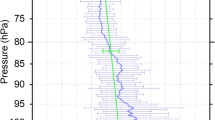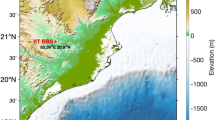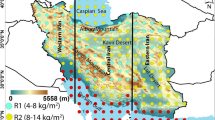Abstract
Balloon-borne cryogenic frost-point hygrometer (CFH) observations over two tropical stations Trivandrum (8.53° N, 76.87° E) and Hyderabad (17.47° N, 78.58° E) [2014–2017] along with Microwave Limb Sounder (MLS) observations [2011–2017] are used to examine the signatures of local and regional dynamics in the distribution of lower stratospheric water vapour over the Indian region. The column-integrated water vapour in the lower stratosphere (IWVLS) varies in the range 2.5–5 g/m2 with low values during winter and high values during summer monsoon and post monsoon seasons. About 50–75% of IWVLS lies in the lower regime of the lower stratosphere, the region from cold point tropopause (CPT) to 21 km (LS1). Hygropause is very near to the CPT in winter and pre-monsoon and 2–3 km above the CPT in summer-monsoon and post-monsoon. The CPT and the minimum in saturated mixing ratio (SMRmin) altitudes show a positive correlation, with SMRmin mostly occurring below the CPT. Though water vapour mixing ratio (WVMR) at CPT increases with increase in SMRmin, it is mostly less than the corresponding SMRmin value. CFH observations showed that the tape recorder signal in the LS1 is disturbed by the local/regional dynamics. While the amount of water vapour entering the lower stratosphere is higher over Hyderabad in winter and summer monsoon, it is higher over Trivandrum in the other two seasons. Hydration at the tropopause level is mainly determined by the overshooting/deep convection, monsoon dynamics and horizontal transport and dehydration is determined by temperature variations in the tropical tropopause layer (TTL).












Similar content being viewed by others
Data availability
The CFH and radiosonde data analysed during the current study will be available on reasonable request to the corresponding author. Other datasets used are available in the public domains. The Aura-MLS data was obtained from NASA through their website (https://disc.gsfc.nasa.gov/). KALPANA-1 and INSAT-3D VHRR Brightness temperature data was obtained from MOSDAC website (www.mosdac.gov.in). NOAA Air Resources Laboratory (ARL) for provided the HYSPLIT transport and dispersion model for calculating the back trajectories used in this paper.
References
Avery MA, Davis SM, Rosenlof KH, Ye H, Dessler AE (2017) Large anomalies in lower stratospheric water vapour and ice during the 2015–2016 El Ninõ. Nat Geosci 10(6):405–409. https://doi.org/10.1038/ngeo2961
Bannister RN, O’Neill A, Gregory AR, Nissen KM (2004) The role of the south-east Asian monsoon and other seasonal features in creating the “tape-recorder” signal in the Unified Model. Q J R Meteorol Soc 130:1531–1554
Berthet G, Renard J-B, Ghysels M, Durry G, Gaubicher B, Amarouche N (2013) Balloon-borne observations of mid-latitude stratospheric water vapour: comparisons with HALOE and MLS satellite data. J Atmos Chem 70:197–219. https://doi.org/10.1007/10874-013-9264-7
Brasseur GP, Orlando JJ, Tyndall GG (eds) (1999) Atmospheric chemistry and global change. Oxford University Press, Oxford, p 654
Brunamonti S, Jorge T, Oelsner P, Hanumanthu S, Singh BB, Kumar KR, Sonbawne S, Meier S, Singh D, Wienhold FG, Luo BP, Boettcher M, Poltera Y, Jauhiainen H, Kayastha R, Karmacharya J, Dirksen R, Naja M, Rex M, Fadnavis S, Peter T (2018) Balloon-borne measurements of temperature, water vapor, ozone and aerosol backscatter at the southern slopes of the Himalayas during Strato Clim 2016–2017. Atmos Chem Phys 18:15937–15957. https://doi.org/10.5194/acp-18-15937-2018
Danielsen EF (1993) In situ evidence of rapid, vertical, irreversible transport of lower tropospheric air into the lower stratosphere by convective cloud turrets and by larger-scale upwelling in tropical cyclones. J Geophys Res 98:8665–8681
Dessler AE, Sherwood SC (2004) Effect of convection on the summertime extra tropical lower stratosphere. J Geophys Res 109:D23301. https://doi.org/10.1029/2004JD005209
Dessler AE, Schoeberl MR, Wang T, Davis SM, Rosenlof KH (2013) Stratospheric water vapor feedback. Proc Natl Acad Sci USA 110(45):18087–18091
Dessler AE, Ye H, Wang T, Schoeberl MR, Oman LD, Douglass AR, Butler AH, Rosenlof KH, Davis SM, Portmann RW (2016) Transport of ice into the stratosphere and the humidification of the stratosphere over the 21st century. Geophys Res Lett 43:2323–2329. https://doi.org/10.1002/2016GL067991
Draxler RR, Hess G (1998) An overview of the HYSPLIT-4 modelling system for trajectories, dispersion, and deposition. Aust Meteorol Mag 47:295–308
Ehhalt DH, Rohrer F, Schauffler S, Pollock W (2002) Tritiated water vapor in the stratosphere: vertical profiles and residence time. J Geophys Res 107(D24):4757. https://doi.org/10.1029/2001JD001343
Emmanuel M, Sunilkumar SV, Muhsin M, Suneel Kumar B, Nagendra N, Ramkumar G, Rajeev K, Parameswaran K (2018) Annual cycle of water vapour in the lower stratosphere over the Indian Peninsula derived from Cryogenic Frost-point Hygrometer observations. Atmos Chem Phys Discuss. https://doi.org/10.5194/acp-2018-630
Emmanuel M, Sunilkumar SV, Muhsin M, Parameswaran K, Satheesh Chandran PR, Suneel Kumar B, Maitra A, Satyanarayana ANV, Nagendra N (2020) Effect of monsoon dynamics and deep convection on the upper troposphere lower stratosphere water vapour over Indian monsoon region. Atmos Res. https://doi.org/10.1016/j.atmosres.2020.105336
Follette-Cook MB, Hudson RD, Nedoluha GE (2009) Classification of Northern Hemisphere stratospheric ozone and water vapor profiles by meteorological regime. Atmos Chem Phys 9:5989–6003
Frey W, Schofield R, Hoor P, Kunkel D, Ravegnani F, Ulanovsky A, Viciani S, D’Amato F, Lane TP (2015) The impact of overshooting deep convection on local transport and mixing in the tropical upper troposphere/lower stratosphere (UTLS). Atmos Chem Phys 15:6467–6486. https://doi.org/10.5194/acp-15-6467-2015
Fueglistaler S, Dessler AE, Dunkerton TJ, Folkins I, Fu Q, Mote PW (2009) Tropical tropopause layer. Rev Geophys 47:RG1004. https://doi.org/10.1029/2008RG000267
Fujiwara M, Hasebe F, Shiotani M, Nishi N, Vömel H, Oltmans SJ (2001) Water vapor control at the tropopause by equatorial Kelvin waves observed over the Galápagos. Geophys Res Lett 28(16):3143–3146. https://doi.org/10.1029/2001GL013310
Fujiwara M, Vömel H, Hasebe F, Shiotani M, Ogino SY, Iwasaki S, Nishi N, Shibata T, Shimizu K, Nishimoto E, Valverde-Canossa MJ, Selkirk HB, Oltmans SJ (2010) Seasonal to decadal variations of water vapour in the tropical lower stratosphere observed with balloonborne cryogenic frost point hygrometers. J Geophys Res 115:D18304. https://doi.org/10.1029/2010JD014179
Ghysels M, Riviere ED, Khaykin S, Stoeffler C, Amarouche N, Pommereau J-P, Held G, Durry G (2016) Intercomparison of in situ water vapor balloon-borne measurements from Pico-SDLA H2O and FLASH-B in the tropical UTLS. Atmos Meas Tech 9:1207–1219. https://doi.org/10.5194/amt-9-1207-2016
Goff JA, Gratch S (1946) Low-pressure properties of water from 160 to 212 °F. Trans Amer Soc Heat Vent Eng 52:95–122
Holton JR, Haynes PH, McIntyre ME, Douglass AR, Rood RB, Pfister L (1995) Stratosphere–troposphere exchange. Rev Geophys 33:403–440
Hurst DF, Hall EG, Jordan AF, Miloshevich LM, Whiteman DN, Leblanc T, Walsh D, Vömel H, Oltmans SJ (2011) Comparisons of temperature, pressure and humidity measurements by balloon-borne radiosondes and frost point hygrometers during MOHAVE-2009. Atmos Meas Technol 4:2777–2793
Hurst DF, Lambert A, Read WG, Davis SM, Rosenlof KH, Hall EG, Jordan AF, Oltmans SJ (2014) Validation of Aura Microwave Limb Sounder stratospheric water vapor measurements by the NOAA frost point hygrometer. J Geophys Res Atmos 119:1612–1625. https://doi.org/10.1002/2013JD020757
Jain AR, Panwar V, Johny CJ, Mandal TK, Rao VR, Gautam R, Dhaka SK (2012) Occurrence of extremely low cold point tropopause temperature during summer monsoon season: ARMEX campaign and CHAMP and COSMIC satellite observations. J Geophys Res 116:D03102. https://doi.org/10.1029/2010JD014340
Jensen EJ, Pfister L (2004) Transport and freeze-drying in the tropical tropopause layer. J Geophys Res 109:D02207. https://doi.org/10.1029/2003JD004022
Johnston BR, Xie F, Liu C (2018) The effects of deep convection on regional temperature structure in the tropical upper troposphere and lower stratosphere. J Geophys Res Atmos 123:1585–1603. https://doi.org/10.1002/2017JD027120
Kalnay E et al (1996) The NCEP/NCAR 40-year reanalysis project. Bull Amer Meteorol Soc 77:437–471. https://doi.org/10.1175/1520-0477
Kanamitsu M (1989) Description of the NMC global data assimilation and forecast system. Weather Forecasting 4:335–342. https://doi.org/10.1175/15200434
Khaykin S, Pommereau J-P, Korshunov L, Yushkov V, Nielsen J, Larsen N, Christensen T, Garnier A, Lukyanov A, Williams E (2009) Hydration of the lower stratosphere by ice crystal geysers over land convective systems. Atmos Chem Phys 9:2275–2287. https://doi.org/10.5194/acp-9-2275-2009
Khaykin S, Pommereau J-P, Hauchecorne A (2013) Impact of land convection on temperature diurnal variation in the tropical lower strtaopshere inefered from COSMIC GPS radio occultations. Atmos Chem Phys 13(13):6391–6402. https://doi.org/10.5194/acp-13-6391-2013
Kley D, Russell III JM, Phillips C (2000) SPARC assessment of upper tropospheric and stratospheric water vapour. WCRP 133, WMO/TD 1043, SPARC Rep. 2. World Clim. Res. Programme, World Meteorol. Organ, Geneva, 312 pp
Lambert A et al (2007) Validation of the Aura Microwave Limb Sounder middle atmosphere water vapor and nitrous oxide measurements. J Geophys Res 112:D24S36. https://doi.org/10.1029/2007JD008724
Lelieveld J, Bruehl C, Joeckel P, Steil P, Crutzen PJ, Fischer H, Giorgetta MA, Hoor P, Lawrence MG, Sausen R, Tost H (2007) Stratospheric dryness: model simulations and satellite observations. Atmos Chem Phys 7:1313–1332. http://www.atmos-chem-phys.net/7/1313/2007/.
Livesey NJ et al (2013) Version 3.3 and 3.4 Level 2 data quality and description document. Jet Propulsion Laboratory Tech. Rep.: JPL D-33509. http://mls.jpl.nasa.gov
MacKenzie AR et al (2006) Tropopause and hygropause variability over the equatorial Indian Ocean during February and March 1999. J Geophys Res 111:D18112. https://doi.org/10.1029/2005JD006639
Mastenbrook HJ (1962) The vertical distribution of water vapour over Hyderabad, India and comparison with mid-latitude distribution. NRL Rep.: 5817
Mastenbrook HJ (1968) Water vapor distribution in the Stratosphere and High Troposphere. J Atmos Sci 25:299–311
Mote P, Rosenlof K, McIntyre M, Carr E, Gille J, Holton J, Kinnersley J, Pumphrey H, Russell J III, Waters J (1996) An atmospheric tape recorder: the imprint of tropical tropopause temperatures on stratospheric water vapor. J Geophys Res 101(D2):3989–4006. https://doi.org/10.1029/95JD03422
Muhsin M, Sunilkumar SV, Venkat Ratnam M, Parameswaran K, Krishna Murthy BV, Emmanuel M (2018) Effect of convection on the thermal structure of the troposphere and lower stratosphere including the tropical tropopause layer in the South Asian monsoon region. J Atmos Sol-Terr Phys 169:52–65. ISSN 1364–6826. https://doi.org/10.1016/j.jastp.2018.01.016
Newell RE, Gould-Stewart S (1981) A stratospheric fountain? J Atmos Sci 38:2789–2796. https://doi.org/10.1175/1520-0469(1981)038%3c2789:ASF%3e2.0.CO;2
Park M, Randel WJ, Gettelman A, Massie ST, Jiang JH (2007) Transport above the Asian summer monsoon anticyclone inferred from Aura Microwave Limb Sounder tracers. J Geophys Res 112:D16309. https://doi.org/10.1029/2006JD008294
Park M, Randel WJ, Emmons LK, Livesey NJ (2009) Transport pathways of carbon monoxide in the Asian summer monsoon diagnosed from Model of Ozone and Related Tracers (MOZART). J Geophys Res 114:D08303. https://doi.org/10.1029/2008JD010621
Ploeger F, Konopka P, Walker K, Riese M (2017) Quantifying pollution transport from the Asian monsoon anticyclone into the lower stratosphere. Atmos Chem Phys 17:7055–7066. https://doi.org/10.5194/acp-17-7055-2017
Poshyvailo-Strube L, Müller R, Fueglistaler S, Hegglin MI, Laube JC, Volk CM, Ploeger F (2022) How can Brewer-Dobson circulation trends be estimated from changes in stratospheric water vapour and methane? Atmos Chem Phys 22(9895–9914):2022. https://doi.org/10.5194/acp-22-9895-2022
Randel WJ, Park M (2006) Deep convective influence on the Asian summer monsoon anticyclone and associated tracer variability observed with Atmospheric Infrared Sounder (AIRS). J Geophys Res 111:D12314. https://doi.org/10.1029/2005JD006490
Randel W, Park M (2019) Diagnosing observed stratospheric water vapor relationships to the cold point tropical tropopause. J Geophy Res Atmos 124:7018–7033. https://doi.org/10.1029/2019JD030648
Randel WJ, Wu F, Russell JM, Roche A, Waters JW (1998) Seasonal cycles and QBO variations in stratospheric CH4 and H2O observed in UARS HALOE data. J Atmos Sci 55:163–185. https://doi.org/10.1175/1520-0469(1998)0552.0.Co;2
Randel WJ, Wu F, Gettelman A, Russell JM III, Zawodny JM, Oltmans SJ (2001) Seasonal variation of water vapor in the lower stratosphere observed in Halogen Occultation Experiment data. J Geophys Res 106(D13):14313–14325
Randel WJ, Zhang K, Fu R (2015) What controls stratospheric water vapor in the NH summer monsoon regions? J Geophys Res Atmos 120:7988–8001. https://doi.org/10.1002/2015JD023622
Read WG et al (2007) Aura Microwave Limb Sounder upper tropospheric and lower stratospheric H2O and relative humidity with respect to ice validation. J Geophys Res 112:D24S35. https://doi.org/10.1029/2007JD008752
Rohs S, Schiller C, Riese M, Engel A, Schmidt U, Wetter T, Levin I, Nakazawa T, Aoki S (2006) Long-term changes of methane and hydrogen in the stratosphere in the period 1978–2003 and their impact on the abundance of stratospheric water vapor. J Geophys Res 111:D14315. https://doi.org/10.1029/2005JD006877
Rolf C, Vogel B, Hoor P, Afchine A, Günther G, Krämer M, Müller R, Müller S, Spelten N, Riese M (2018) Water vapor increase in the lower stratosphere of the Northern Hemisphere due to the Asian monsoon anticyclone observed during the TACTS/ESMVal campaigns. Atmos Chem Phys 18:2973–2983. https://doi.org/10.5194/acp-18-2973-2018
Rosenlof KH (1997) Hemispheric asymmetries in water vapor and inferences about transport in the lower stratosphere. J Geophys Res Atmos 102:13213–13234. https://doi.org/10.1029/97JD00873
Rosenlof KH (2002) Transport changes inferred from HALOE water and methane measurements. J Meteorol Soc Jpn 80(4B):831–848
Schoeberl MR et al (2006) Overview of the EOS Aura mission. IEEE Trans Geosci Remote Sens 44:1066–1074
Schwartz MJ, Read WG, Santee ML, Livesey NJ, Froidevaux L, Lambert A, Manney GL (2013) Convectively injected water vapor in the North American summer lowermost stratosphere. Geophys Res Lett 40(2316–2321):2013. https://doi.org/10.1002/grl.50421
Shepherd TG (2002) Issues in stratosphere-troposphere coupling. J Meteorol Soc Jpn 80(4B):769–792
Singh BB et al (2021) Linkage of water vapor distribution in the lower stratosphere to organized Asian summer monsoon convection. Clim Dyn 57:1709–1731. https://doi.org/10.1007/s00382-021-05772-2
Solomon S et al (2010) Contributions of stratospheric water vapor to decadal changes in the rate of global warming. Science 327(5970):1219–1223. https://doi.org/10.1126/.science.1182488
Sunilkumar SV, Babu A, Parameswaran K (2013) Mean structure of the tropical tropopause and its variability over Indian longitude sector. Clim Dyn. https://doi.org/10.1007/s00382-012-1496-8
Sunilkumar SV, Muhsin M, Emmanuel M, Ramkumar G, Rajeev K, Sijikumar S (2016) Balloon-borne cryogenic frost-point hygrometer observations of water vapour in the tropical upper troposphere and lower stratosphere over India: First results. J Atmos Sol Terr Phys 140:86–93
Suzuki J, Fujiwara M, Nishizawa T, Shirooka R, Yoneyama K, Katsumata M, Matsui I, Sugimoto N (2013) The occurrence of cirrus clouds associated with eastward propagating equatorial n = 0 inertio-gravity and Kelvin waves in November 2011 during the CINDY 2011/DYNAMO campaign. J Geophys Res 118(23):12941–12947. https://doi.org/10.1002/2013JD019960
Tinney EN, Homeyer CR (2021) A 13-year trajectory-based analysis of convection-driven changes in upper troposphere lower stratosphere composition over the United States. J Geophys Res Atmos 126(3):e2020JD033657. https://doi.org/10.1029/2020jd033657
Tinney EN, Homeyer CR, Elizalde L, Hurst DF, Thompson AM, Stauffer RM, Vömel H, Selkirk HB (2022) A modern approach to stability-based definition of the tropopause. Mon Weather Rev (published online ahead of print 2022). https://journals.ametsoc.org/view/journals/mwre/aop/MWR-D-22-0174.1/MWR-D-22-0174.1.xml
Ueyama R, Jensen EJ, Pfister L (2018) Convective influence on the humidity and clouds in the tropical tropopause layer during boreal summer. J Geophys Res-Atmos 123:7576–7593. https://doi.org/10.1029/2018JD028674
Ueyama R, Jensen EJ, Pfister L, Krämer M, Afchine A, Schoeberl M (2020) Impact of convectively detrained ice crystals on the humidity of the tropical tropopause layer in boreal winter. J Geophy Res Atmos 125:e2020JD032894. https://doi.org/10.1029/2020JD032894
Vömel H, David DE, Smith K (2007) Accuracy of tropospheric and stratospheric water vapor measurements by the cryogenic frost point hygrometer: instrumental details and observations. J Geophys Res 112:D08305. https://doi.org/10.1029/2006JD007224
Vömel H, Naebert T, Dirksen R, Sommer M (2016) An update on the uncertainties of water vapor measurements using cryogenic frost point hygrometers. Atmos Meas Tech 9:3755–3768. https://doi.org/10.5194/amt-9-3755-2016
Wang PK, Setvak M, Lyons W, Schmid W, Lin H-M (2009) Further evidences of deep convective vertical transport of water vapor through the tropopause. Atmos Res 94:400–408
Wang X, Dessler AE, Schoeberl MR, Yu W, Wang T (2019) Impact of convectively lofted ice on the seasonal cycle of water vapor in the tropical tropopause layer. Atmos Chem Phys 19(14621–14636):2019. https://doi.org/10.5194/acp-19-14621-2019
Wang T, Zhang Q, Hannachi A, Hirooka T, Hegglin MI (2020) Tropical water vapour in the lower stratosphere and its relationship to tropical/extratropical dynamical processes in ERA5. Q J R Meteorol Soc 146:2432–2449. https://doi.org/10.1002/qj.3801
Waters JW et al (2006) The Earth Observing System Microwave Limb Sounder (EOS MLS) on the Aura satellite. IEEE Trans Geosci Remote Sens 44(5):1075–1092
Wright JS, Fu R, Fueglistaler S, Liu YS, Zhang Y (2011) The influence of summertime convection over southeast Asia on water vapor in the tropical stratosphere. J Geophys Res 116:D12302. https://doi.org/10.1029/2010JD015416
Ye H, Dessler AE, Yu W (2018) Effects of convective ice evaporation on interannual variability of tropical tropopause layer water vapor. Atmos Chem Phys 18:4425–4437. https://doi.org/10.5194/acp-18-4425-2018
Yu W, Garcia R, Yue J, Russell J, Mlynczak M (2022) Variability of water vapor in the tropical middle atmosphere observed from satellites and interpreted using SD-WACCM simulations. J Geophys Res Atmos 127:e2022JD036714. https://doi.org/10.1029/2022JD036714
Zahn A, Christner E, van Velthoven PFJ, Rauthe-Schöch A, Brenninkmeijer CAM (2014) Processes controlling water vapor in the upper troposphere/lowermost stratosphere: an analysis of 8 years of monthly measurements by the IAGOS-CARIBIC observatory. J Geophys Res Atmos 119:11505–11525. https://doi.org/10.1002/2014JD021687
Acknowledgements
CFH observations used for this study were conducted as a part of TTD (Tropical Tropopause Dynamics) experiments under the GARNETS (GPS Aided Radiosonde Network Experiment for Troposphere-stratosphere Studies) programme of Space Physics Laboratory (SPL). The authors are thankful to the technical and scientific staff of SPL and METF (Meteorological Facility) of VSSC and TIFR-BF (Tata Institute of Fundamental Research-Balloon Facility) for their dedicated efforts in conducting the CFH experiments. We thank the MLS team for providing H2O data and MOSDAC team for KALPANA/INSAT-3D data. The authors acknowledge the NOAA Air Resources Laboratory (ARL) for the provision of the HYSPLIT transport and dispersion model used in this paper.
Funding
The authors declare that no funds, grants or other support were received during the preparation of this manuscript.
Author information
Authors and Affiliations
Contributions
All authors contributed to the study conception and design. Field experiment and data collection, methodology, formal analysis, writing-original draft: ME. Supervision, conceptualization, experiment design and execution, methodology and reviewing and editing manuscript: SVS. Field experiment and data collection: SC and MM
Corresponding author
Ethics declarations
Conflict of interest
The authors declare that they have no conflict of interest.
Additional information
Publisher's Note
Springer Nature remains neutral with regard to jurisdictional claims in published maps and institutional affiliations.
Rights and permissions
Springer Nature or its licensor (e.g. a society or other partner) holds exclusive rights to this article under a publishing agreement with the author(s) or other rightsholder(s); author self-archiving of the accepted manuscript version of this article is solely governed by the terms of such publishing agreement and applicable law.
About this article
Cite this article
Emmanuel, M., Sunilkumar, S.V., Satheesh Chandran, P.R. et al. On the signatures of local and regional dynamics in the distribution of lower stratospheric water vapour over Indian region using balloon-borne and satellite observations. Clim Dyn 61, 3379–3396 (2023). https://doi.org/10.1007/s00382-023-06749-z
Received:
Accepted:
Published:
Issue Date:
DOI: https://doi.org/10.1007/s00382-023-06749-z




